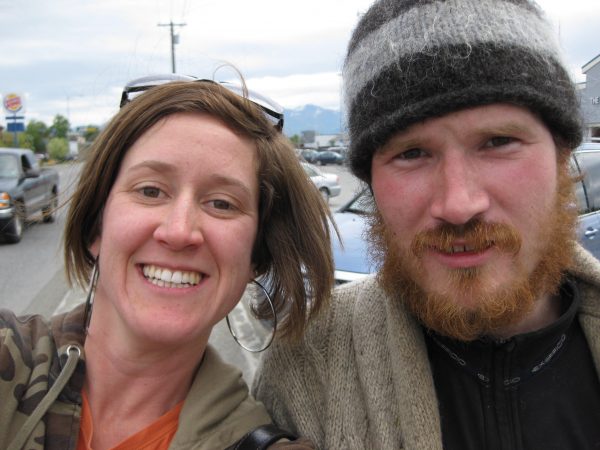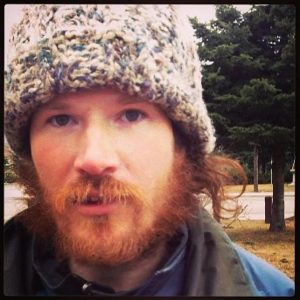
Author Marin Sardy grew up in Anchorage, fishing, hiking and camping with her family — all experiences Sardy remembers fondly. But she also saw her brother, who suffered from schizophrenia, go from a hearty, adventurous Alaska man, to living homeless in Anchorage.
Sardy has a book out this month titled “The Edge of Everyday: Sketches of Schizophrenia.” She calls it a memoir in fragments, and it looks at her very personal experiences with mental illness in her family. A piece from Sardy’s book was featured in the New Yorker magazine recently, called, “My Brother Tom’s Schizophrenia.”
Sardy spoke with Alaska Public Media’s Casey Grove.
Sardy: So my brother developed, began to develop, schizophrenia in his early or mid-20s and the story in the New Yorker traces a path over a period of several years of our attempts, our repeatedly failed attempts, to try to get consistent lasting and effective help for him. And much of the difficulty was because he was initially resistant to the idea of receiving treatment for schizophrenia, which is common. And we were struggling to try to convince him to accept the help that was available. But he ended up spending several years living as a homeless man on the streets of Anchorage, and we continued to try to help him at that time. We periodically were able to get temporary help for him, but it did not last and so the story sort of recounts his homeless years in Anchorage and describes how it was ultimately that we failed to help him over the long term.

Grove: You wrote in this piece that he was a skier, a mountain climber, had even climbed the Moose’s Tooth, and he had all the ability to survive outside and to make a camp and whatnot. Do you think that there’s a unique thing about that a guy suffering from mental illness could still, in Alaska, you know, take care of himself?
Sardy: Yes, I mean, I think it speaks enormously to many of my brother’s strengths. For one, he was unbelievably tough. He grew up, you know, skiing, hiking, camping, and in his later teenage and early 20s, he got into mountain climbing, even, he was a rock climber. And he was very intelligent as well. So despite how incapacitating his mental illness was in many ways, I think he still had those strengths that he could draw on to some degree. I mean, I still don’t know that I can quite understand how he survived so long. I think he survived seven Alaskan winters, I think, being essentially homeless and that’s kind of unimaginable to me. So I think it speaks to all the things he was good at. And additionally my brother, he had people who loved him and there was a network in the community of our friends and people who knew his story who did what they could to help him, who let him sleep on their couch during the cold snaps, who would give him food, who would do things like that for him. It took the community and I think a lot of love for for Tom to get him through that.
Grove: The state has been really struggling to figure out how to improve conditions at the Alaska Psychiatric Institute and how to fund it. I wonder what you think about really what is a lack of services it seems like.
Sardy: Well, I think that the major problem that we encountered with services was that there was simply a strong focus on crisis care and then much less available to work with in terms of follow-up and more consistent care to prevent relapse and my brother, you know, he would start to spiral down. So I don’t really know what the best solution is and looking back, I certainly can’t know what might have helped my brother, might have resulted in my brother still being alive today. But I do think that a lack of options was part of our problem, and I think that once my brother was homeless and in an ongoing psychotic state because he was off medication, he did not have nearly as many connections to the community that he could make use of to find his way back on to a better path. And that was something that we were always struggling with. So I would just say that more services, just in the basic sense, was what we were wishing for. API was not set up to handle people on the long-term basis. My brother seemed to feel comfortable at API, but then he would need to be shifted into transitional housing. And for reasons that I’m not even clear about., he struggled enormously in the transitional housing. The environment was not one in which he felt comfortable. I think when he was still having very significant symptoms. It was overwhelming for him at times, and when he got overwhelmed, he would just go back outside. So there was no place where we could have him be safely indoors in a way that worked for him.
Grove: Just hearing you say that it makes me think about people’s projections of what homelessness looks like. What do you think about that? I mean when people see a homeless person out on the street.
Sardy: I often got the question of, you know, “How is your brother homeless?” He was not — he didn’t fit people’s ideas of what a homeless person is, and I’m not sure what those ideas were, but I do think there was an assumption that addiction was involved in some way, and certainly there are negative attitudes towards addiction problems that influence people’s perceptions of homelessness, but my brother in fact did not have drug and alcohol problems, and that was not a component of his homelessness at all. And so I was always just trying to impress upon people that we were trying our hardest to help him, but the way things were panning out it just never worked. But I think a major hurdle for my brother was the idea that he had schizophrenia and the idea that he had a condition that was potentially going to require him to take medication indefinitely. I think he had a hard time personally coming to terms with that idea, which I imagine was very difficult to do, especially to do when he was, you know, in a compromised state of mind as a result of the condition. So the stigma that we carry as a society people with schizophrenia certainly receive, they understand that people might think less of them or might look down on them if they have this diagnosis. And I do think that if my brother had grown up in a society that did not have such negative attitudes towards schizophrenia and negative stereotypes of it, I believe that he could have much more easily come to terms with this idea that he had this diagnosis and that maybe what he wanted to do rather than push it away would be to deal with it so that he could, you know, live his fullest life.
Sardy’s brother, Tom, died in Anchorage in 2014.
Casey Grove is host of Alaska News Nightly, a general assignment reporter and an editor at Alaska Public Media. Reach him at cgrove@alaskapublic.org. Read more about Casey here.





